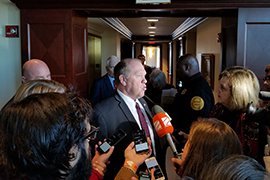- Slug: BC-CNS-ICE Defense,720
- Photos available (thumbnails, captions below)
By BRYAN PIETSCH
Cronkite News
WASHINGTON – The acting director of Immigration and Customs Enforcement defended his agency recently against charges of racism, saying at a Washington event that 89 percent of those arrested last year by ICE have a criminal history.
“The reality is, we are focused on the criminals,” Thomas Homan said at the event hosted last week by the Center for Immigration Studies.
“They want to call us racists, they want call us Nazis. You can not like what we do, but don’t vilify the men and women that took an oath … simply doing their job,” he said.
Advocates were quick to call out Homan, noting that many of those he includes in his numbers were convicted of minor crimes.
“The ICE director is clearly lying to justify the fact that he is not targeting real, hardcore criminals,” said Rep. Ruben Gallego, D-Phoenix, when asked about Homan’s statement. “(He’s) just trying to create a mass-deportation force.”
Homan’s 89 percent statement came from an ICE report that said of the 143,470 people the agency arrested last year, 74 percent had one or more criminal convictions and another 15 percent faced criminal charges.
But the number of arrests last year was up from previous years – 110,104 in fiscal 2016 and 119,772 in fiscal 2017. And as the number of arrests have gone up, the percentage who had criminal convictions has gone down, falling from 85 percent in 2015 and 86 percent in 2016 to the 74 percent last year.
The percent of non-criminals deported also rose during President Donald Trump’s first year in office. In 2016, roughly 7 percent of people deported had not been convicted of a crime, a percentage that more than doubled to 16 percent in 2017.
And critics argue that even for those with criminal convictions, few were for the type of crime that people think of when Trump talks about deporting “bad hombres.”
The crimes range from traffic violations to homicide, and one immigrant may have more than one conviction by the time ICE catches up with them. But convictions for driving under the influence, drugs, immigration and traffic offenses were the most frequent, with 59,985 DUI convictions and 43,908 traffic convictions.
High-profile crimes like homicide were significantly less frequent, with the 1,531 convictions in 2017 accounting for just 1 percent of the total arrested.
Kevin Appleby, director of public policy at the Center for Migration Studies, said that putting crimes like traffic offenses and homicide on the same playing field hurts people who are “virtual Americans, except on paper.”
“They’re not threats to the community. They have jobs, families, and homes – they’re part of the American fabric,” Appleby said. “From a humanitarian perspective, they’re not committing a crime. But ICE may categorize them as such.”
But Jessica Vaughan, director of policy studies at the Center for Immigration Studies, said the severity of the crime doesn’t matter. Her organization advocates for stricter enforcement of immigration law, while Appleby’s center advocates for immigrant rights.
“The fact that there are more DUIs than murders is irrelevant as far as immigration enforcement is concerned,” Vaughan said.
“What they’re really being removed for is not the crime, it’s the fact that they’re in the country illegally,” she said. “Them committing the crime is what brought them to ICE’s attention and moved them to the top of the list for deportation.”
Vaughan’s comments are in line with ICE’s current policy, which doesn’t prioritize arresting criminals over non-criminals.
“As ICE leadership has made clear since early 2017, the agency will no longer exempt classes or categories of removable aliens from potential enforcement,” ICE public affairs officer Matthew Bourke said in an email. “All of those in violation of the immigration laws may be subject to immigration arrest, detention and – if found removable by final order – removal from the United States.”
Immigration advocates call that misguided, arguing that it makes more sense to prioritize the deportation of people with histories of serious crime – the people Trump famously called “bad hombres” – which was the policy under President Barack Obama’s administration.
“What makes the most sense is for ICE to go back to the policy of meaningful prioritization for serious crimes and felonies,” said Carlos Guevara, senior policy adviser at UnidosUS. “Focus on the quality of enforcement over the quantity.”
For more stories from Cronkite News, visit cronkitenews.azpbs.org.
^__=
Web links:
_ CIS event video: https://www.c-span.org/video/?c4733459/tom-homan
_ ICE 2017 removals report: https://www.ice.gov/sites/default/files/documents/Report/2017/iceEndOfYearFY2017.pdf
_ Trump “bad hombres”: https://youtu.be/NveATfcxta4
^__=
Immigration and Customs Enforcement officers take part in a Philadelphia raid in May that led to 49 arrests. The agency’s director recently defended his officers, saying 89 percent of those arrested by ICE had a criminal history. (Photo courtesy Immigration and Customs Enforcement)
Thomas Homan, acting director of U.S. Immigration and Customs Enforcement, in an October 2017 file photo. Homan, speaking in Washington last week, said ICE agents should not be vilified for “simply doing their job” that Congress set for them. (Photo by Andrew Nicla/Cronkite News)

